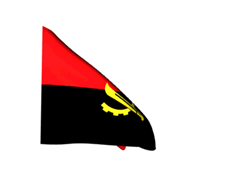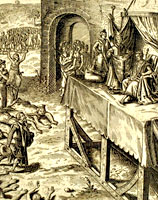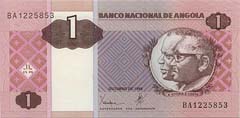









Tel Code..: +244
Air France- Alitalia - Austrian Airlines- KLM- Lufthansa- THY-Lufthansa-British Airways
Viza..: Needs
Courses or boosters usually advised: Hepatitis A; Poliomyelitis; Tetanus; Typhoid; Yellow Fever.
Other vaccines to consider: Cholera; Diphtheria; Hepatitis B; Meningococcal Meningitis; Rabies.
Yellow fever vaccination certificate required for travellers over 1 year of age arriving from countries with risk of yellow fever transmission.
Name: Angola
President: Josť Eduardo dos Santos (1979)
Prime Minister: position abolished (2012)
Total area: 481,350 sq mi (1,246,699 sq km)
Population (2012 est.): 18,056,072 (growth rate: 2.78%); birth rate: 39.36/1000; infant mortality rate: 83.53/1000; life expectancy: 54.59; density per sq mi: 25
Capital and largest city (2009 est.): Luanda, 4,511,000
Other large cities: Huambo, 979,000; Lubango, 136,000
Monetary unit: New Kwanza
Read more: Angola:
Maps, History, Geography, Government, Culture, Facts, Guide & Travel/Holidays/Cities
| Infoplease.com http://www.infoplease.com/country/angola.html#ixzz38beo6R9Z
For many centuries before European incursions,
Bantu tribes inhabited the geographical area now called Angola.
 It took many centuries
for the Bantu people to establish themselves, and along the way numerous tribes
emerged. One of the first was the Kingdom of Kongo, who arrived in the 13th
century. Their wealth derived mainly from agriculture and trade, and power lay
in the hands of the Mani aristocrats.
It took many centuries
for the Bantu people to establish themselves, and along the way numerous tribes
emerged. One of the first was the Kingdom of Kongo, who arrived in the 13th
century. Their wealth derived mainly from agriculture and trade, and power lay
in the hands of the Mani aristocrats.
The Portuguese began
arriving in the late 1400s bringing firearms, many advances in technology, and
Christianity. Close relations between the two were quickly established, and in
return, the King of Kongo offered plenty of slaves, ivory, and minerals for Portugal.
The Portuguese explorer
Paulo Dias de Novais founded Luanda in 1575, with a hundred families of settlers
and four hundred soldiers. Subsequently the Portugueseestablished
several settlements and trading posts along the coast.
In the late 16th century the slave trade flourished here, and reportedly it was
responsible for the exportation of over three million native Africans (against
their will) to the Portuguese colony
of Brazil.
By the 19th century Angola became a colony of Portugaland
a major exporter bananas and coffee. However, the desire for independence grew
stronger and stronger, and in response the Portuguese provoked
an armed conflict in 1961.
 After nearly 15
years of warfare, Angola achieved independence in 1975.
After nearly 15
years of warfare, Angola achieved independence in 1975.
The new country should have flourished as it contained a massive diamond and oil
reserve (worth
billions),
however instead, a 27-year civil war followed. Nearly 1.5 million Angolans died,
and 4 million were displaced as a result.
On the positive side, and because of oil, Angola's economy has grown since the
conflict ended in 2002, but it still faces huge social and economic problems. In
fact, most Angolans are still trapped in poverty.
Most of the (mentioned oil reserves) are found in the enclave of Cabinda, and
according to an Americanfoundation,
oil production from Angola has increased so significantly that Angola now is China's biggest
supplier of oil.

Angola consists of four principle regions: an arid coastal lowland, hills and
mountains that rise inland, a vast plain known as the high plateau (planalto),
and rain forest.
The mostly flat coastal plain stretches inland for 30 to 100 miles into a belt
of rolling hills and a series of scattered mountains.
The highest point of the country, Morro de Moco, peaks at 8,592 ft (2,620 m),
and is located in the Ahaggar Mountains. Conversely, the lowest point of the
country is the Atlantic
Ocean (0
m).
Angola's elevated high plateau rises 4,000 to 6,000 ft. (1,200 to 1,800 m), lies
to the east of the hills and mountains and dominates Angola's terrain.
The Zambezi River and several tributaries of the Congo River flow through
Angola. Additional rivers of importance include the Cubango, Cuando and Cuango.
Also of note are the Kalandula Falls located on the Lucala River. At 344 ft.
(105 m) the Kalandula are one of the largest waterfalls in Africa based
on volume.
The Northern Angolan province of Cabinda is separated from the mainland by a
narrow strip of land belonging to the Democratic
Republic of Congo (DRC).
Climate:
Like the rest of tropical Africa,
Angola also experiences distinct, alternating rainy and dry seasons.
The coastal areas are dry and hot in the south, with a short rainy season (February
through April).
In the north conditions are dry and hot May through October, with an extended
rainy season November to April.
Within the interior hills and eastern plateaus, the temperatures and rainfall
decreases. Cooler conditions are common in the higher elevations throughout both
summer and winter.
Angola's rich agricultural sector was formerly the mainstay of the economy and currently provides employment for the majority of the people. Food must be imported in large quantities, however, because of the disruption caused by the country's protracted civil war. All areas of production suffered during the fighting that began in 1975. Coffee and sugarcane are the most important cash crops. Sisal, corn, cotton, manioc, tobacco, and bananas are raised, and fishing is also important. Livestock, notably cattle, sheep, goats, and pigs, is raised in much of the savanna region.
Angola has substantial mineral resources and hydroelectric power. Most large-scale industries are nationalized. Oil, chiefly from reserves offshore, is the most lucrative product, providing about 50% of the country's GDP and 90% of its exports. Oil revenues have not done much to improve the economy at large or the everyday lives of Angolans, especially in the interior, because huge sums have been spent on the armed forces and lost due to government corruption; unaccounted losses to government funds were estimated at $32 billion in 2011. Diamond mining is also a principal industry; for many years in the late 20th cent. revenue from the mines supported UNITA rebels (see under Postcolonial History ). Natural gas is produced, and Angola has deposits of iron ore, phosphates, copper, feldspar, gold, bauxite, and uranium. Industries include metals processing, meat and fish processing, brewing, and the manufacture of cement, tobacco products, and textiles.
The Benguela railroad, which carries metals from the mines of Congo (Kinshasa) and the Zambian Copperbelt, was an important source of revenue, but much of the line fell into disrepair during the civil war. Angola's road network and communications system have also been affected by civil strife. In 2005, the government began using a line of credit from China to help rebuild the country's infrastructure; rail lines began resuming service in 2010. Luanda and Lobito are Angola's main shipping ports. The country's main trading partners are the United States, China, South Korea, Portugal, and France. Angola is a member of the Southern African Development Community.
Angola is governed under the constitution of 2010. The executive branch is headed by the president; the leader of the party or coalition that receives the most votes in the National Assembly elections is elected to the office. The president, who serves as both head of state and head of government, may serve two five-year terms. The unicameral National Assembly has 220 members who are elected by proportional vote on a national (130) or provincial (90) basis for four-year terms. Adminstratively, the country is divided into 18 provinces.
The Biť Plateau, which forms the central region of the territory, has an average altitude of 6,000 ft (1,830 m). Rising abruptly from the coastal lowland, the plateau slopes gently eastward toward the Congo and Zambezi basins and forms one of Africa's major watersheds. The uneven topography of the plateau has resulted in the formation of numerous rapids and waterfalls, which are used for the production of hydroelectric power. The territory's principal rivers are the Cuanza and the Cunene. Rainfall in the south and along the coast north to Luanda is generally low. In northern Angola it is usually dry and cool from May to October and wet and hot from November to April. The characteristic landscape is savanna woodlands and grasslands. The northeast, however, has densely forested valleys that yield hardwoods, and palm trees are cultivated along a narrow coastal strip.
In addition to Luanda, other important cities are Huambo, Lobito, Benguela, and Namibe. The overwhelming majority of Angola's population is of African descent, and most of the people speak Bantu and other African languages. The official language, however, is Portuguese, though French is the predominate European language in Cabinda. The Ovimbundu, Kimbundu, and Bakongo are the largest ethnic groups. After Angola secured its independence from Portugal, many Europeans left the country. Traditional indigenous religions prevail, but there is a large Roman Catholic minority and a smaller Protestant minority.